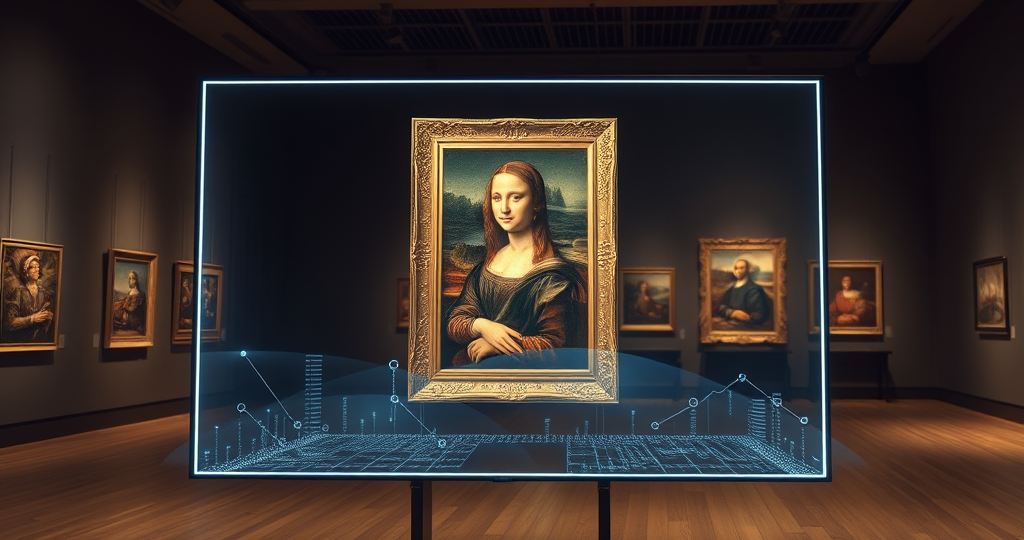
Art has always been a bridge between past, present and future, a tangible testament to human creativity and cultural evolution. However, as we advance into an increasingly digital world, traditional art faces mounting challenges—preservation, accessibility, and security, just to mention a few. Enter Real-World Asset (RWA) tokenization, or perhaps better said AAT (Art-Assets Tokenisation), groundbreaking innovation that offers museums and private collections the opportunity to better safeguard and enhance their assets in ways never before possible.

1. The Digital Twin Revolution: Beyond the Physical Realm
One of the most compelling applications of RWA tokenization is the creation of digital twins—high-fidelity replicas of physical artworks stored on the blockchain. These digital counterparts open up great possibilities, ensuring the longevity of an artwork beyond its physical lifespan. Museums and collectors can now:
- Integrate into the Metaverse: A digital twin enables artworks to be showcased in virtual galleries, allowing global audiences to engage with them in immersive ways, even if they can’t visit the museum or collection in person.
- Preserve Cultural Heritage: If a physical artwork is ever damaged or lost due to unforeseen circumstances (natural disasters, theft, or deterioration), a detailed digital record ensures that its essence is never truly lost.

2. Enhancing Art Conservation
The conservation of artwork is a never-ending battle against time, environmental factors, and human error. While meticulous restoration techniques exist, they often alter the original piece. Digital twins serve as a safeguard:
- Damage Mitigation: A digital twin provides a perfect reference for future restoration efforts, ensuring that any restoration remains true to the original.
- Decentralized Storage: Blockchain-based records guarantee that digital copies of valuable art remain secure, even if physical archives or traditional digital backups fail.

3. Authenticity, Security, and Traceability
Forgery and illicit trade have plagued the art world for centuries. Tokenization introduces a layer of transparency and trust that revolutionizes art authentication:
- Blockchain Provenance: Each tokenized artwork comes with an immutable record detailing its ownership history, exhibition records, and authenticity.
- Enhanced Security: Smart contracts can automatically verify and enforce ownership rights, reducing disputes and fraud.
- Institutional Confidence: Museums and private collectors can confidently acquire tokenized artworks, knowing they have a verified, traceable lineage.

4. Democratizing Art Education
Art education has traditionally been limited by geography and accessibility. RWA tokenisation bridges this gap, making art more inclusive:
- Interactive Learning: Digital twins can be integrated into virtual reality (VR) and augmented reality (AR) experiences, allowing students and art enthusiasts to engage with masterpieces in unprecedented ways.
- Global Accessibility: Tokenised art enables online galleries, interactive museum tours, and decentralized educational initiatives, fostering a broader appreciation of art and its history.
- AI-Driven Curation: With AI tools analyzing artworks, users can receive personalized recommendations and insights, deepening their understanding of artistic movements and individual works.

5. New Revenue Streams for Museums and Private Collectors
Beyond preservation and education, RWA tokenisation introduces new financial opportunities for institutions and collectors:
- Fractional Ownership: Museums and collectors can tokenize art pieces into fractional shares, allowing art enthusiasts and investors to own a stake in a masterpiece without requiring full ownership.
- Royalties & Smart Contracts: Digital twins can generate perpetual revenue through licensing fees or resale royalties, ensuring that artists and institutions benefit from the continued success of their collections.
- Expanding Audience Engagement: By offering exclusive digital experiences, such as NFT-backed memberships or VIP virtual tours, museums can attract younger, tech-savvy audiences while maintaining financial sustainability.
Conclusion: A New Era for Art and Cultural Heritage
RWA tokenization is more than just a technological advancement—it’s a paradigm shift in how we preserve, authenticate, and share art. By embracing blockchain-backed digital twins, museums and private collectors are not only safeguarding their assets but also unlocking unprecedented opportunities for exposure, education, and financial sustainability.
As the world continues to blend the physical with the digital, tokenization stands as a beacon of innovation, ensuring that art remains not just an artifact of the past, but an evolving, living entity accessible to all.
Related external articles:
- https://www.scalingparrots.com/en/nft-for-art-and-museums/
- https://blockapps.net/blog/case-studies-successful-tokenization-of-famous-artworks/
- https://cuseum.com/blog/2021/11/16/how-21-museums-amp-cultural-organizations-engaged-with-nfts-in-2021
- https://www.museumnext.com/article/we-asked-the-experts-what-can-nfts-do-for-museums/
- https://www.mdpi.com/2076-0752/13/1/16


You must be logged in to post a comment.